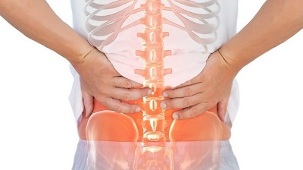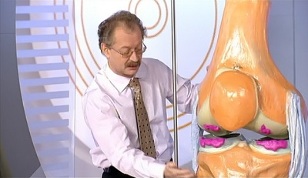
Osteochondrosis is one of the most common problems associated with back disease.
This condition means a change in the internal shape of the spine, as well as a decrease in the plasticity of the discs located between the vertebrae, during which disorders related to cellular nutrition occur.
The lumbar spine suffers the most because it is this part of the spine that takes on the most load. When lifting heavy objects, all of the force that your body is exposed to is directed towards the distance between the vertebrae, resulting in compression of the nerve roots. That is why there are problems and pain associated with lumbar osteochondrosis.
Causes of lumbar osteochondrosis
These reasons can arise even in the younger generation, especially if there are different types of problems associated with the musculoskeletal system. These include:
- congenital malformations, for example, different lengths of limbs;
- flat feet of different types and stages;
- changes in the shape of the spine (scoliosis);
- change in the location of the lumbar vertebra, which may slide out of the sacrum in different directions.
These diseases have the ability to have a negative impact on the spine, provoke violations of its functions. Often, doctors believe that lumbar osteochondrosis can arise at the genetic level. For example, if your parents suffered from this disease, there is a high probability that their child also suffers from such diseases of the spine.
In addition, the most well-known cause of the disease is hard physical labor. This is because when lifting too heavy objects there is a large load on the lumbar spine, which leads to its violation.
The next cause of lumbar osteochondrosis is obesity. Extra pounds, like ballast, accumulate on the body and in the body, which has a negative effect on the spine and vertebrae, causing heaviness and pain during movement. If at first glance it seems to you that a violation of the shape of the spine will not lead to negative consequences, then you are greatly mistaken. This problem leads to the wear of the discs located between the vertebrae, which leads to the further development of osteochondrosis. Hence, it is imperative to monitor the condition of your body and avoid excess body fat. Fat tissue interferes with movement, adding additional stress to your muscles, joints, ligaments, and spine.
Another not unrecognized cause of spinal disease is back injury. Impacts, bruises, heavy lifting and shells in athletes who are not prepared for such loads have a negative effect on the back. Injury to one of the spinal sections can lead to negative consequences in the future, for example, osteochondrosis of the spine.

And the most popular cause of back disease is, as everyone knows, an inactive lifestyle, when most of the time a person spends sitting in one place, not doing sports or stretching. Most often this applies to people who work in offices or just like to stay in one place for a long time without movement, do not exercise or stretch. To maintain a healthy back and spine (and for the whole body in general), you need adequate physical activity. If you move around a little and constantly sit down, it can lead to impaired blood circulation in the body. Due to this factor, back pain occurs, the body does not receive all the nutrients, weakening of the spine and many other diseases occur.
A healthy lifestyle is one of the assumptions of healthy blood vessels and joints. Take the time to exercise regularly and your body will respond positively to it.
Diseases caused by infections or inflammatory processes in the body adversely affect bone tissue and the condition of ligaments, which can lead to weakening of the vertebrae. Most of all loads are taken by the lumbar region, which can lead to a change in the shape of the vertebrae.
Stress also causes pain in the spine, especially in women, as they experience feelings and emotions more strongly. Stress negatively affects the health of the body as a whole, its nervous system. Against the background of stress, various types of diseases, including lumbar osteochondrosis, can get worse and inflamed.
Help!You need to carefully monitor your nerves and avoid situations associated with irritation or negative emotions.
Symptoms of lumbar osteochondrosis
It is very difficult to identify the disease at the initial stage. Most illnesses are asymptomatic, however, everyone is able to experience non-standard sensations in the body. Therefore, it is extremely important to determine the first symptoms of the disease of the spine. The pains come gradually, you need to be able to correctly identify them and timely contact a specialist, because in the early stages it is easier to cure the disease.
Most symptoms share a single characteristic:

- Pain in the lumbar region. In total, two types stand out: neurogenic pain and muscle pain. The intervertebral disc itself does not feel pain, because it does not contain nerve endings. Painful sensations arise as a result of the destruction of the nerve root discs that emerge from the opening between the vertebrae.
- The pain is too sharp, as if you are pulling. A person grasps the lower back and is unable to straighten up for fear of feeling pain again. Such pain occurs as a result of swelling of the nerve root, which does not have enough space to stay.
- In addition, the pain is caused by swelling of the back muscles. With edema, there is a problem with the supply of glucose and air to the muscle fibers of the back. This is why the muscles are stressed. They suffer from starvation and also have the ability to remove lactic acid from the fibers that have formed in them during muscle activity. Consequently, the muscle undergoes contraction, which causes pain and spasms. The person experiences pain, stiffness and uncomfortable sensations in the back and lower back.
- Since the disk has the ability to squeeze the root of the motor, an attack of paresis or paralysis is possible. There may be a feeling of weakness in the limbs, which contributes to an impaired gait.
- Muscle wasting can occur, in which one of the limbs decreases in size. Feelings of numbness in the legs, goosebumps also appear, the growth of scratches and nails on the limbs is disturbed.
Scoliosis can have serious consequences, including injury and disruption of internal organs.
Here are the general signs and symptoms of lumbar osteochondrosis:
- root pain;
- muscle pain in the back;
- movement disorders;
- tenderness of limbs;
- frightening sensations, numb legs, stopping hair growth and nail plate.

Being overweight is another enemy of your joints and spine.
If your muscle corset is not sufficiently strengthened, the joints will take the load on themselves, resulting in injury.
These symptoms are the main ones, however, it must be answered that there are also individual symptoms which do not occur in every patient. They depend on the individual characteristics of the person and are the most difficult to identify or define.
Stages of lumbar osteochondrosis
The disease develops in four stages.
First stage- the initial stage of the disease. Along with it, the patient has pain in the lower back, as well as spasms of her swelling in this area of the spine. Paying attention to symptoms and seeing a specialist in time can help prevent further back problems. At this stage, the treatment is carried out quite easily and quickly, allowing you to get rid of problems and pain in the back.
Second stage- at this stage the pains become more constant and severe than in the first. In the joints and ligaments of the spine, sensations of unusual mobility may appear, as a result of which the pain sensations intensify, become sharper and more palpable. Painful sensations are caused by the contraction of the sciatic nerve. In some cases, violations of the internal organs of a person are possible. It is imperative to consult a specialist for the correct selection of treatment.
Third stage- at this stage, hernias between the vertebrae have already formed. The spine begins to bend, changing its shape in different directions (scoliosis, lordosis and other diseases of the spine are formed). Painful sensations are constant, vivid and tormenting for a person. The full value of life becomes problematic because a person is constantly constrained by pain. Treatment at this stage may be delayed as the disease begins to progress.
TheStep 4is the most difficult step. Back pain is regular, sometimes even constant. A person cannot move completely, pain interferes with movement. If the treatment is not prescribed in time, the patient may remain disabled.
Treatment of lumbar osteochondrosis
The treatment for this disease is very complex. Full treatment is needed. It includes:
- treatment with drugs;
- adherence to a therapeutic regimen;
- for severe stages of the disease - surgical intervention;
- perform special physical activities selected by the attending physician.
To reduce swelling in the back muscles, a salt-free diet is necessary because it retains water in the body. In case of illness, it is necessary to use a special orthopedic corset to keep the muscles in the desired position.
Use of special ointments and plasters that have a warming effect. However, it should be remembered that if inflammatory processes occur in your body, the use of warming drugs is unacceptable, as this will increase the symptoms of inflammation.
Acute pain is treated with intramuscular injections prescribed by the attending physician. If the pain is intense and unbearable, it is possible to use intramuscular anesthetics.

Physiotherapy is a painless process to speed up the treatment of lumbar osteochondrosis. Remember that the treatment should be comprehensive and under the supervision of the attending physician.
Physiotherapy is a must in the treatment of lumbar osteochondrosis. It is carried out in medical establishments. The physical activity is carried out after a preliminary warm-up of the muscle tissue of the patient.
The main principle of treatment is movement to tone muscle fibers. It is imperative to restore the motor function of muscle tissue so that there is a full range of motion. Most often, in the early stages, osteochondrosis is treated for several weeks. In advanced stages with severe pain and symptoms, treatment may be delayed. That is why it is very important to pay attention to painful sensations in the back area in time and to consult a specialist.
Important!The sooner you start treatment, the faster you can get over the disease.
Prevention of lumbar osteochondrosis
Preventing this disease will never be superfluous.
Please follow these guidelines to avoid this problem:
- Stay cool, dress for the weather to keep your back healthy.
- Avoid heavy lifting. If you need to move heavy items, carry them in your backpack. Untrained athletes are strongly advised not to immediately jump onto heavy working weights.
- Avoid falling onto your back, especially in the cold winter weather. Any kind of back injury leads to its illnesses.
- Drink plenty of clean water and other fluids.
- Keep in shape so that being overweight does not cause this type of illness.
- Exercise regularly and stretch your muscle fibers.
- Stretch your back muscles. You can hang on to the bar or go for a swim in the pool.
- Get regular medical exams. You can do a spine x-ray or an MRI to monitor the condition and health of your back.

Hyperextension Back Extender is a great way to strengthen the muscles that support the spine.
If you follow these simple guidelines, you can prevent back problems including lumbar osteochondrosis. If you suddenly experience any unusual sensations in your back, you should immediately contact your doctor.
Conclusion
Monitor the health of your back and spine to avoid associated problems and illnesses. To do this, you need moderate physiotherapy exercises, which will help tone muscles and prevent a number of diseases that occur in various parts of the back. If pain of different types is detected, it is necessary to contact a specialist in a timely manner in order to consult and obtain the correct and correct decision, since in the early stages of the disease the disease is easily treatable. Do not run yourself and your health, as your life and freedom of movement depend on the health of your back when you perform routine activities of daily living.
We hope that the article has been useful to you, that you have learned new points about Lumbar Osteochondrosis, and that you can now avoid this problem. Be healthy and take care of yourself, because a healthy back ensures the health of the whole body, a long and happy life without pain!



































